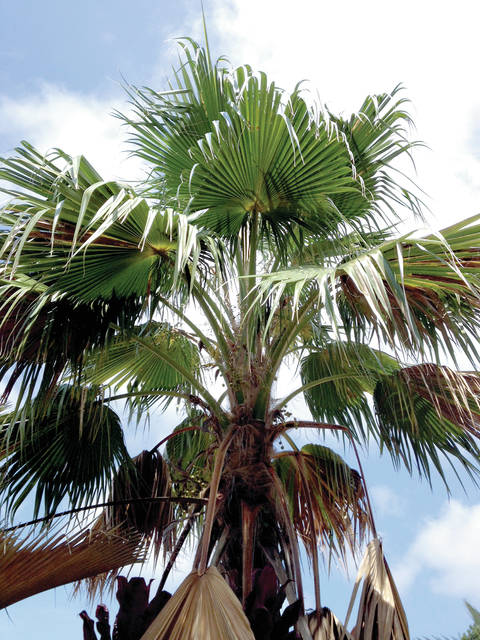We are blessed with natural beauty wherever we look around our island, but it is easy to take for granted.
We often forget the efforts of folks today and years gone by. A visit to Lili‘uokalani Gardens last week for the second annual Banyan Drive Art Stroll reminded us of all the work that KT Cannon-Eger and many volunteers put forth to keep this valuable community resource alive.
There are many other examples of horticultural contributions such as the palm, tropical rhododendron and bamboo gardens at the Panaewa Zoo. So to get in the know them, the Hawaii Chapter of the American Rhododendron Society is inviting folks who want to learn about tropical Vireya rhododendrons to their hands-on plant propagation program at noon today (Jan. 21) at Keaau Community Center.
Call president Sherla Bertelmann at 966-9225 for details.
If you want to get involved with the Hawaii Island Palm Society, call Bob Gibbons at 333-5626. They are having a rare palm auction and program presented by Tom Mirenda with Hawaii Tropical Botanical Gardens on Friday, Feb. 9, at Aunt Sally’s Luau Hale in Hilo. The public is invited, but reservations should be made no later than Feb. 2.
Then there is a unique educational garden almost lost to our island community until recently. It is one that represents Hawaiian agriculture before Captain Cook’s arrival.
Hawaiian gardens today are very different than before European contact in the late 17th century. When the first Polynesians migrated from somewhere to the west, they brought with them a form of agriculture that was as close to sustainable as possible. That method of farming is alive today because many kupuna of the Hawaiian community have worked to keep it so.
A fine example of these efforts is the Amy Greenwell Ethnobotanical Garden in mauka Kona. Thanks to Amy Greenwell, Bishop Museum, Peter Van Dyke, a past director and a host of island volunteers, this ethnobotanical garden was able to teach these techniques to thousands of school children and adults throughout the years. Not only was sustainable Hawaiian agriculture taught, but the cultural and spiritual components were incorporated as well.
This came to an abrupt end when Bishop Museum announced it would be selling this valuable educational farm center. The good news, according to Janet Britt, is that the Friends of Amy B.H. Greenwell Ethnobotanical Garden has received a major financial grant to help save this unique resource. More money must still be raised to succeed.
According to Maile Melrose, president of the Friends group, there now is a drive to save this special place. The garden is just mauka of Manago Hotel, where you can have a meal of their famous pork chops. For further information about how you can help, call Maile at 323-3378.
To learn more about Amy, the Greenwell family and many other historical figures of Kona, you also can call or visit the Kona Historical Society.
•••
When you visit the many islands of the South Pacific, such as the Marquesas, Society, Cook, Samoa and Tonga, you will see how similar the agriculture practices are to Hawaiians of the past.
What must it have been like for the first Polynesian pioneers who found Hawaii and developed these islands we call home. The forests in those earliest days of human activity were very different then when Captain Cook arrived.
What is now pasture used to be forests. Trees such as loulu palms flourished in abundance, but it wasn’t long before the introduction of pigs and rats radically changed things. We have no real clear records of that time, but throughout Polynesia, it is obvious humans and their activities have had a tremendous impact on the species that evolved on the many isolated islands of the Pacific.
Today, erosion is a big problem on most high islands because of damage being done by feral grazing animals such as goats. The rising ocean is swallowing the low atolls that have been the homes of islanders for thousands of years.
The moral of this story is that we better learn to adapt to change but keep as many of the good qualities of past sustainable systems that we can. We can do this by supporting education using the vision of Amy Greenwell and the Hawaiian community.
As individuals, we can then be conservationists right in our own gardens.
We can grow native and canoe plants.
We also can plant species to encourage desirable wildlife such as our native birds if we live in an upland forest area.
In the lowlands, we can protect our shorebirds and even enjoy wildlife and birds such as mynas, doves, tropical finches and cardinals.
We have a wide variety of plants, native and introduced by the Polynesians and other cultures, to follow. Therefore, we have a tremendous array for beauty and food sources.
There are a number of trees that can help accomplish this purpose. Among the best are natives such as the loulu palms, ohia, koa, wiliwili, hoawa, alahe‘e and alali‘i. Other plants, such as the beach and mountain naupaka, are attractive and make good ornamentals for a garden.
So, when you find yourself mourning the loss of days gone by, remember our today will hopefully be remembered as the good old days to future islanders. We need to think about how we can ensure the future will include the best part of the past.
This is what Amy Greenwell Ethnobotanical Garden has done for our island, and we pray, with community support, it will continue long into the future.



